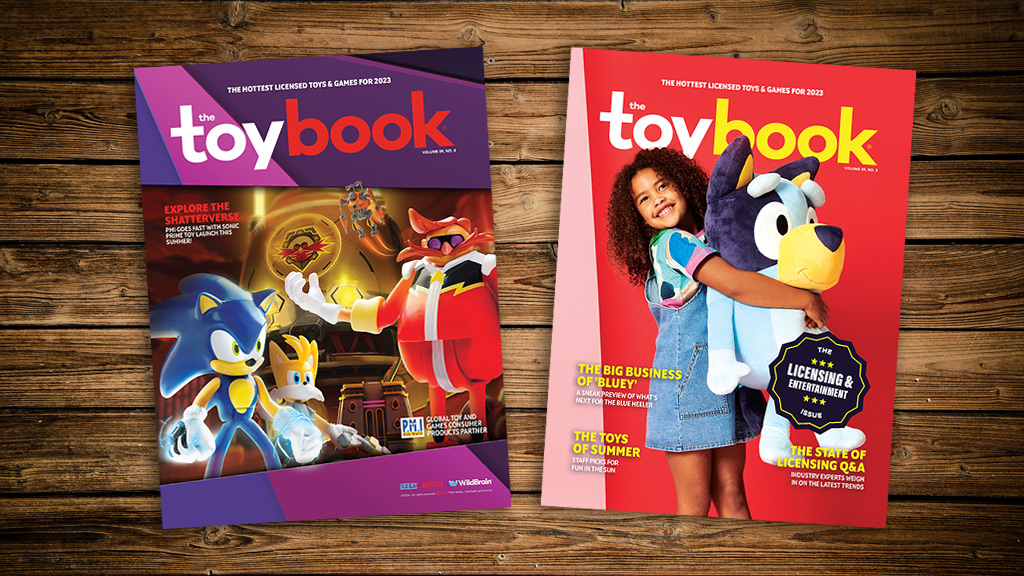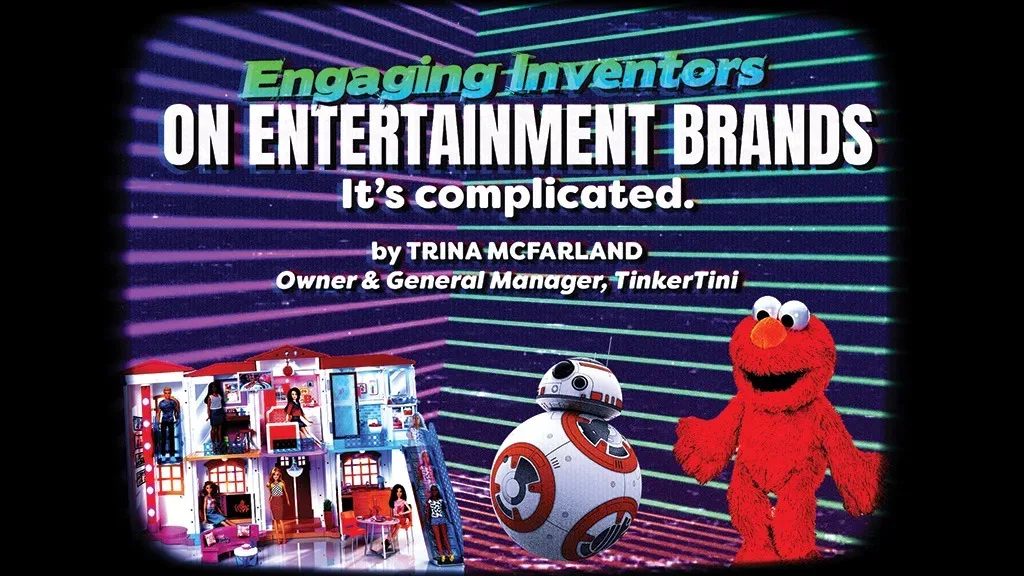by TRINA MCFARLAND, owner and general manager, TinkerTini
Entertainment licensors have the desire to connect directly with inventors. But why? Don’t their licensees manage inventors and engage them to support the brands they have rights to? Whose responsibility is it to engage with, inspire, and manage inventors and their concept submissions — the licensors or licensees? In my opinion, both!
We frequently see entertainment licensors at inventor pitch events, and some even have their own focused inventor outreaches … I would know because I created and managed the Disney Consumer Products program nearly 20 years ago, and more recently helped Universal Brand Development pilot and structure its own inventor outreach. The benefits of connecting with inventors are clear from the licensor’s perspective. Inventors can deliver hit products and help drive entertainment brands to become evergreen. Elmo is a great example of that. Our furry red friend from Sesame Street has enjoyed many years of retail success and gained priority from the inventing community over the years as the license has passed between several toymakers.
But there is more complexity to establishing a direct relationship between inventors and entertainment licensors than one might assume. Typically, licensors don’t have much visibility to the invention pipeline, as the submission and review process is managed and looked after by their licensees. The manufacturers have to sign the deals and take the risks, so it’s their final decision to license an inventor concept and then turn it into a product. They’d often prefer that licensors stay out of this workflow. From their perspective, it’s challenging enough to stay on a development schedule and execute the mutually agreed-upon line strategy. Tossing in a handful of inventor concepts off-timing can be very disruptive to the working teams, so for practical reasons, licensors are often held at a distance from the inventor concept evaluation process happening behind closed doors.
As a result, licensors often wonder what they’re not seeing and what might be missed. Licensors are the most knowledgeable when it comes to their properties. They live and breathe their brands and stories alongside filmmakers and creators every day. Based on my personal experience managing licensor-driven inventor outreaches, employees from the licensor side will almost always see something in an inventor concept that the licensees may not. They will spot opportunities — especially for white space — that licensees miss because they are focused on executing their established line plans. Their focus is narrower and their goals more immediate. Different expertise, priorities, and perspectives matter when you’re reviewing inventor concepts because they are often the starting place of what could, under the right circumstances, become the next Tickle Me Elmo.
Licensors can and should be involved in inspiring and educating inventors to “share their expert lens.” Currently, inventors rely on licensees to shuffle down strategy for their product development needs in regular wish lists, but details can get lost in translation, or worse, not communicated at all.
Things like character attributes, tent pole events, key magic moments in content, and toyetic accessories or elements are all important for inventors to understand. But it’s hard when an inventor is, for example, spending time and resources to invent on a “horse-focused” property and they don’t know if it is realistic or fantastical. Do they have saddles? Do they interact with anything as part of the story? Are there any human characters? All of those details matter and can impact what they are creating.
That said, if licensors want to better partner with licensees and encourage focused work from inventors, it helps to come to the table with inventor royalty relief. It demonstrates a serious commitment to product innovation with practical support for their partners.
The current industry standard license rate to inventors when their concepts are used on entertainment brands is 3%. Some licensors will offer 1.5% royalty relief to essentially split the bill with their partner, while others may offer to pay the inventor’s bill with the full 3% royalty relief. These terms may or may not be included in master license agreements. How licensors value and make space for inventors is all over the place.
Now, let’s assume all entertainment licensors say, “Yes Trina, you’re right and I’m in and will agree to royalty relief and find a way to make the space for inventors on my brands.” That’s great, but we have another hurdle to overcome: the issue of workflow and controlling exposure points when it comes to reviewing inventor concepts. Licensees are typically buttoned up with an established process and submission protocols that help protect the company from frivolous claims. It’s unfortunate, but claims can happen if the way concepts come into a company isn’t thoughtfully managed. Companies with a responsibly managed inventor outreach have portals, processes, and experienced staff in place to manage concept submissions and are under the watchful eye of corporate legal teams. In a case where concepts are flying around willy-nilly over email from a licensor that doesn’t have any real understanding of how they are obligating themselves or their partners, that licensor is the proverbial “bull in the China shop.”
Following money and process, the last hurdle is the most difficult to navigate because it’s not rational or grounded in good business sense. It has a term: “Not Invented Here Syndrome.” It has many facets, but the primary one can be hard to hear. Sometimes design leaders have a bigger ego than their internal teams’ capabilities. Resistance to accepting help or working in partnership with top inventing talent alongside their licensors can be costly to the company and its relationships with licensors in the long haul.
So how can we better merge the worlds of inventors, licensees, and licensors given all the challenges I’ve just summarized? Here are some suggestions that I hope will receive some consideration:
ENTERTAINMENT LICENSORS
- Royalty relief: 3%. Provide it, not as charity, but as an investment.
- Create wish lists. Provide them to your licensees. Ask to see how and what your licensees are communicating to inventors about your brands. It is fair to ask for this visibility.
- Pay attention. Ask your licensees how many inventors they work with and how many concepts they review a year. Ask how their inventor relations teams work and are set up and will support your brands with focus.
- Pitch call-outs. Don’t be afraid to ask what is an inventor concept when you are being pitched. Any good pitch will have a mix of concept sourcing.
- Stay in the lines. Respect your licensee’s submission process and don’t go around their established submission protocols. If you aren’t sure about their process, clarify. And if they don’t have a formal process, consider what that might mean for your brands.
- Respect. Do not show inventor concepts to anyone outside of your company without explicit approval from the inventor, especially retail buyers. You may inadvertently impact the inventor’s ability to sell something and make a living. Inventors are individuals. These oversights hurt them in real ways financially.
ENTERTAINMENT LICENSEES
- If you are using inventor concepts to pitch for business, secure them with something or your competition may use the same exact concept in their pitch.
- Ensure you are communicating wish lists and updates with inventors on a regular basis. Share them with your licensors and invite their feedback.
- Welcome your licensors into your process of working with inventors and dedicate support to ensure their needs are covered with focus as concepts are reviewed by the company as a whole.
- Ask for royalty relief and communicate inventor concepts to licensors early in the process.
- Involve your licensors in regular, brand-focused inventor pitch meetings. Unify your comments and expedite the process. Go exploring for more opportunities together.
- Ask inventors for their permission to present and obtain preliminary approval from your licensors. Your Inventor Submission Agreements may allow you to do this, but still, ask. It’s polite.
I sincerely hope this helps both sides of the fence consider how they can both make some changes to be better together and help our inventing community engage with even more success in the future. Group hugs!

A version of this article was originally published in the 2023 Licensing & Entertainment Issue of The Toy Book. Click here to read the full issue! Want to receive The Toy Book in print? Click here for subscription options!


